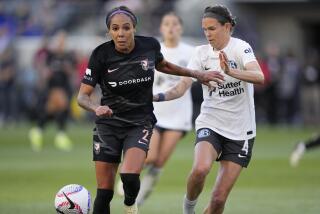ANALYSIS : Players’ Victory Not Easy
- Share via
One strange thing about life in this country--the world’s shining democracy--is that, every so often, inalienable rights have to be fought for.
The Americans who produced the Declaration of Independence, the Constitution and the Bill of Rights two centuries ago made everything easy, ostensibly.
But it isn’t easy.
Thus the American employers who, years ago, forced men, women and children to work 10, 12 and more hours a day didn’t simply relent when asked to relent. The 40-hour week had to be fought for.
Black citizens who wanted to enroll at the university of their choice couldn’t merely show up at the front door. The right to attend a preferred school had to be fought for.
And more recently, the pro football players who wanted a right that every other citizen has in America--to work for the employer of their choice--couldn’t get it by just asking. It had to be fought for.
Did it ever.
For 20 years, NFL players have been fighting for free agency--in the streets, in the courts and at endless numbers of bargaining tables.
They finally won it in a settlement Wednesday, only after a series of strikes, lockouts, threats and, among other things, one bizarre interlude when the owners played four or five regular-season games with what they called replacement teams and what NFL players called scabs.
What’s more, free agency came to pro football only under the hammer of the country’s court system.
At the hour of settlement, all of the players who had walked the first NFL picket lines in the 1970s, bravely defying the club owners who controlled their destiny, were long gone.
As the owners said at the time, the 1970s strikers weren’t going to win anything. And they haven’t. They’re all too old to play football now. Some are dead.
One irony is that the strikers were only asking for 55% of the NFL’s gross. When the owners made peace this week, they committed to a minimum of 62% of their gross for player payrolls.
How did the players get that done? Are they smarter now than the players were in the 1970s and ‘80s? What led the owners to grant free agency to most five-year veterans now, and, shortly, to most four-year veterans?
The history of the NFL labor movement is clear. The turning point was November of 1989, when the NFL Players Assn. disbanded as a trade union and set up shop as a trade association.
That made one critical difference:
--As a union, the players hadn’t been able to win in court because of promises they had made in collective bargaining agreements.
In effect, the players had freed the owners from the restrictions of antitrust legislation.
--As an association, the players could win, and did win repeatedly, because the owners could no longer stand on negotiated antitrust exemptions.
Said NFLPA chief counsel Richard Berthelsen: “If a court holds that the provisions of a (collective bargaining agreement) are in force, the Rams can tell a player he must play for them if he wants to play in the NFL.
“If there isn’t any such agreement, it is illegal restraint of trade under (antitrust law) to tie a player to one team.”
It was on the advice of Berthelsen that executive director Gene Upshaw decertified the NFLPA as a union.
“In ordinary labor relations, football players don’t have a level playing field when they’re bargaining with owners,” Berthelsen said. “The owners can just overpower a union.
“In 1982, for example, the owners got a multimillion-dollar advance from (NBC and CBS) to fight us during (a strike). The NFL is a powerful monopoly. The networks had to do it.
“In 1987, the owners (broke the strike) by putting NFL scab games on the networks. When Congress and the courts allow scabs to replace union workers, it’s hard to win a strike.
“(Antitrust laws) protected the owners as long as we were a union. When we decertified, we could oppose them in court as equals.”
And Wednesday’s landmark agreement was the eventual result of that.
The NFL’s salary cap provisions in the new agreement differ greatly from basketball’s and that proposed for baseball.
Baseball owners, whose payrolls aren’t capped, are further at the mercy of the arbitration cases that have had the effect of driving up salaries for free agents.
And NBA owners can exceed their cap by several million to sign one of their own players.
Pro football’s owners have strenuously opposed both arbitration and an NBA-style cap on grounds that in either instance, salaries are uncontrollable.
The NFL wanted a hard cap and got it.
In pro football, the new cap will be based eventually on an agreement to commit a club minimum of 58% and a league maximum of 62% of most NFL revenues for player costs, including pensions.
The owners, in return, have agreed to make most of their veteran players unrestricted free agents.
It’s a litigation agreement that will be replaced by a collective bargaining agreement when the NFLPA resumes as a union.
Settlement terms were imaginative and unprecedented. Thus, as announced Wednesday, the contract provides for significant changes in its seventh and last year, when the salary cap will be removed, and when the free-agency requirement will be increased from four to six years.
“That feature is designed to get the two sides back to the bargaining table before the seventh year,” NFL Vice President Joe Browne said. “And I’m sure it will work.”
More to Read
Go beyond the scoreboard
Get the latest on L.A.'s teams in the daily Sports Report newsletter.
You may occasionally receive promotional content from the Los Angeles Times.










